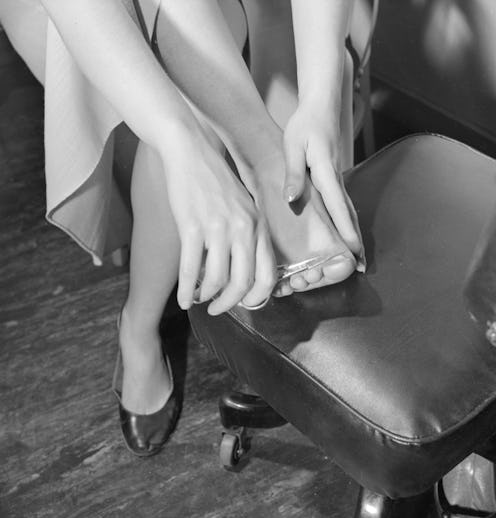Health
Here’s What COVID Toes Feel Like
Why COVID can cause discoloration or blisters on your feet.

By now, we can all recite COVID symptoms like a memorized school lesson: fever, cough, shortness of breath, loss of taste and smell. But for some people who've contracted the virus, there's an unexpected symptom that happens way down in their feet. COVID toes, as they're being called, aren't exactly intuitive: what does a respiratory virus have to do with your feet?
What Are COVID Toes & What Do They Feel Like?
"COVID toes are a discoloration of the toes to a blue-purple color," Dr. Natasha Bhuyan M.D., regional medical director at OneMedical, tells Bustle. The condition can look pretty alarming, and can be painful, with blisters or sores. The World Health Organization categorizes them as a less common symptom of COVID-19. According to one study published in Journal of Wound, Ostomy and Continence Nursing in 2020, a little over 15% of people with COVID-19 showed these symptoms; first toes turn red and swollen, then they'll begin to develop blueish-purple tinges. The American Academy of Dermatology says toes might itch, ache, or throb, and could also develop areas of rough skin, or painful bumps.
Dr. David Cutler M.D., a family medicine physician at Providence Saint John's Health Center, says that it will look and feel similar to chilblains, which happen when your feet are warmed too quickly after being freezing cold, and the blood vessels become inflamed.
Why Do COVID Toes Happen?
There are a few theories about why COVID toes occur. "Researchers think it’s related to the impact of COVID on our tiny blood vessels, which in turn, impede blood flow," Dr. Bhuyan says. According to a study published in The Lancet in May 2020, COVID virus attacks cells that line various parts of the body, including the lungs and the circulatory system — and that means the blood vessels in the toes might feel the impact, too. If they're restricted, blood can't reach your toes, meaning they turn a rich shade of blue. As blood returns irregularly, it could cause chilblain-like sores.
"COVID toe could be caused by inflammation from injured blood vessels as a result from the body's immune response, or as a direct result of being infected by the virus," Dr. Vivek Cherian M.D., an internal medicine physician, tells Bustle. Right now it's not clear what's responsible. Another study published in International Journal of Infectious Disorders in January 2021 suggested that COVID toes might be linked to people walking around barefoot around their house during the pandemic.
COVID toes may also be a misnomer. "Most people only develop this on their toes, but the condition can also develop on the fingers or both," Dr. Cherian says. Interestingly, studies have shown that young adults and children who don't develop other symptoms of COVID, like coughs or muscle aches, are the ones most likely to get COVID toes. "This isn't what we thought would happen," Dr. Bhuyan says.
How Do You Treat COVID Toes?
However COVID toes happen, their treatment is pretty simple: rest. "It will generally appear late in the course of a COVID infection and resolve within a few weeks," Dr. Cutler says. If you see discoloration of your toes, even if you've had no other COVID symptoms, Dr. Bhuyan says you should contact a doctor; it could be COVID, but you could also have chilblains or other circulation problems. While you're figuring it out, self-isolate and get a COVID test if you can. In the meantime, it's time for your warmest, comfiest pairs of socks.
Experts:
Dr. Natasha Bhuyan M.D.
Dr. Vivek Cherian M.D.
Dr. David Cutler M.D.
Studies cited:
Baeck, M., & Herman, A. (2021). COVID toes: where do we stand with the current evidence?. International journal of infectious diseases : IJID : official publication of the International Society for Infectious Diseases, 102, 53–55. https://doi.org/10.1016/j.ijid.2020.10.021
Beuscher, T. L., & Andrews, S. E. (2020). What Are COVID Toes? A Case Study. Journal of wound, ostomy, and continence nursing : official publication of The Wound, Ostomy and Continence Nurses Society, 47(6), 619–621. https://doi.org/10.1097/WON.0000000000000711
Hernandez, C., Bruckner, A.L. (2020) Focus on “COVID Toes”. JAMA Dermatol. 156(9):1003. doi:10.1001/jamadermatol.2020.2062
Koschitzky, M., Oyola, R. R., Lee-Wong, M., Abittan, B., & Silverberg, N. (2021). Pediatric COVID Toes and Fingers. Clinics in Dermatology, Advance online publication. https://doi.org/10.1016/j.clindermatol.2020.12.016
Massey, P. R., & Jones, K. M. (2020). Going viral: A brief history of Chilblain-like skin lesions ("COVID toes") amidst the COVID-19 pandemic. Seminars in oncology, 47(5), 330–334. https://doi.org/10.1053/j.seminoncol.2020.05.012
Varga, Z., Flammer, A. J., Steiger, P., Haberecker, M., Andermatt, R., Zinkernagel, A. S., Mehra, M. R., Schuepbach, R. A., Ruschitzka, F., & Moch, H. (2020). Endothelial cell infection and endotheliitis in COVID-19. Lancet (London, England), 395(10234), 1417–1418. https://doi.org/10.1016/S0140-6736(20)30937-5
This article was originally published on